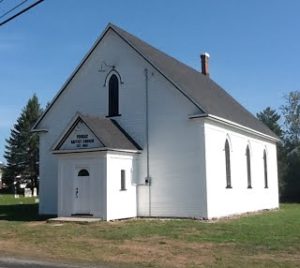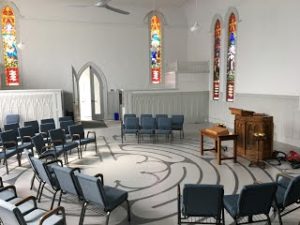Old Churches, New Futures
By Lee Sochasky, AHNB Board member
New Brunswick’s historic church buildings give a unique window into our province’s past, and future. Our early churches were founded on social and economic concepts that changed dramatically after WWII – and at an accelerating pace now – and a growing number of church buildings have been abandoned or demolished, as not fitting with the times. These buildings are an important part of our national heritage. Their rapid loss led the National Trust for Canada to create a special initiative to save more of them: https://regenerationworks.ca/places-of-faith/
Can our historic churches find new futures in today’s fast-changing society? Yes, by looking to creative local solutions and centuries-old concepts. Some examples:
Central United Church and The Community Peace Centre, Moncton 
The Central United Church has been at the same location since 1877 and in its present stone structure since 1916. In 2008, recognizing its mission extended far beyond its dwindling congregation, Central United began working with community non-profit organizations to build a 80,000-square foot Community Peace Centre on land it owned beside the church. The new Centre opened in 2012 and now houses the area’s United Way, Volunteer Centre, Multicultural Association and other social support groups. Through its vision for the Peace Centre, Central United is now actively supporting its local Mission and Service goals and maintaining its historic building. Learn more at: https://centralunitedmoncton.com/about-us/history/ and http://www.communitypeacecentre.com/
InterAction School of Performing Arts, formerly Germain Street Baptist Church, Saint John 
The Germain Street Baptist Church has been at the same location since 1818 and, following the Great Fire of 1877, in its present stone structure since 1879. In 2010, recognizing the unsustainable cost of maintaining the building, the congregation chose to merge with another church and sell its historic property. With creative community thinking, a tenant and soon owner – the InterAction School of Performing Arts (founded in 2001, the church purchased in 2013) has adapted the large sanctuary into a professional performance venue and other parts of the building into teaching and office space. This historic downtown church building now has a vibrant and creative new life. Learn more at: https://www.iactspa.com https://www.iactspa.com/sanctuary-theatre
Penniac Baptist Church, Penniac
Penniac is a rural community on the Nashwaak River, northeast of Fredericton. Its historic Baptist Church was boated across the river to its current location in 1864 and was actively used until 1994. In 2016, local residents formed a non-profit group, Friends of the Penniac Baptist Church and Cemetery, to preserve the church building’s integrity and use it for new community uses, which it does to this day. Learn more at: https://www.cbc.ca/news/canada/new-brunswick/penniac-baptist-church-river-road-1.4872308.
A very helpful guide has also been produced that can be viewed on the AHNB web site under “Resources”.
Wesley United Church, St. Andrews 
Wesley United Church has been at the same site since 1831 and in the same building since 1867. As its community service role evolved in recent years, the church found its building wasn’t effectively serving the groups that had come to rely on it. After much thought, in 2019 it chose to renovate its sanctuary into a multi-purpose public space while retaining its heritage character. The pews came out, chairs went in, the choir loft was rebuilt into a stage and the original wood plank floor was painted with a spiritual labyrinth. A wheelchair accessible washroom and kitchenette were added. The re-envisioned space now serves a Sunday congregation but also the community’s food bank, arts, family, music and contemplative groups. Learn more at: https://wesleyunitedchurchstandrewsbytheseanb.ca/sanctuary-renovations/
Four historic churches, four different approaches to preserving their structures while pursuing ‘non-traditional’ courses. Or maybe not. In centuries long past, buildings built for religious purposes were also the master hall for the community, used for markets, performances and meetings. What was old is new again. New Brunswick churches are showing that this works.
Lee Sochasky has spent a career as an inter-disciplinary regional planner, with heritage as one of her disciplines. Her heritage recognitions include a National River Conservation award from the federal Department of Canadian Heritage and a Maine Tourism Award for the Arts, Heritage and Cultural Community.
